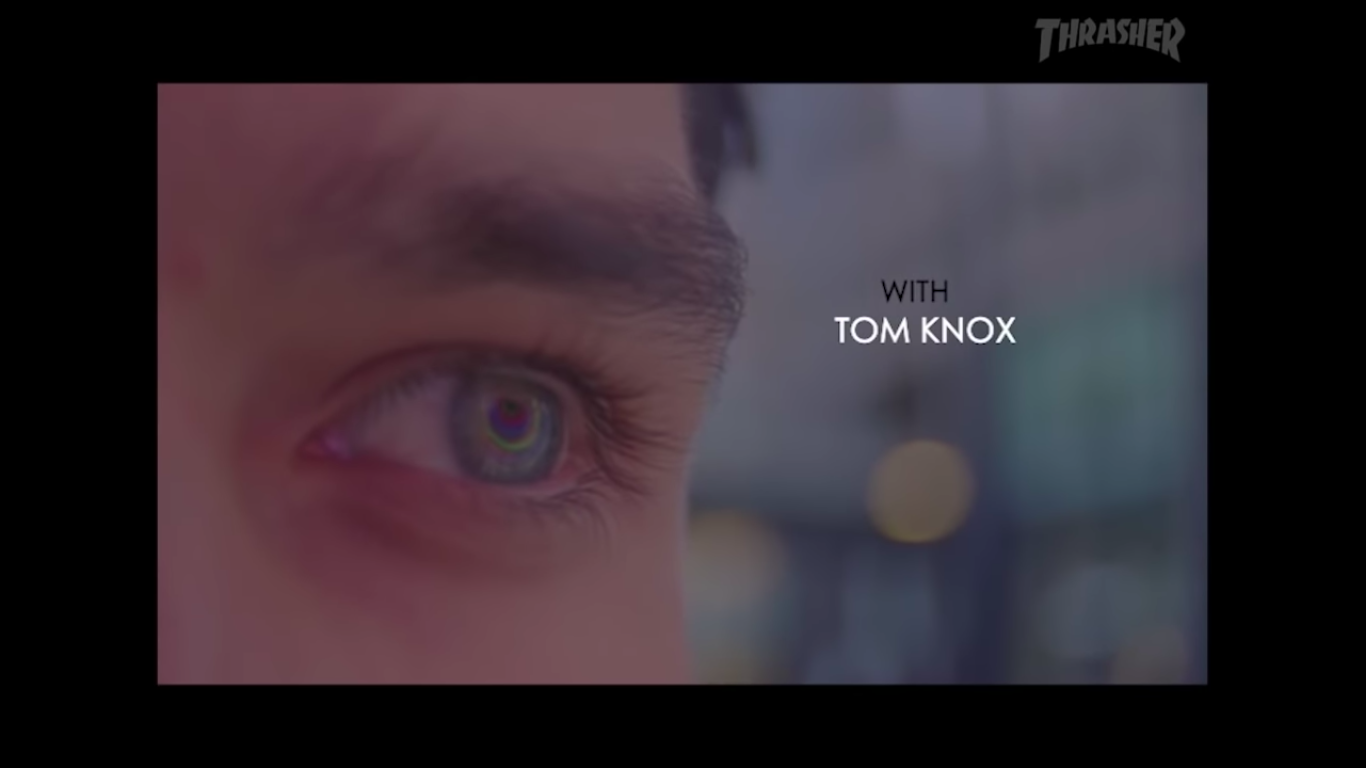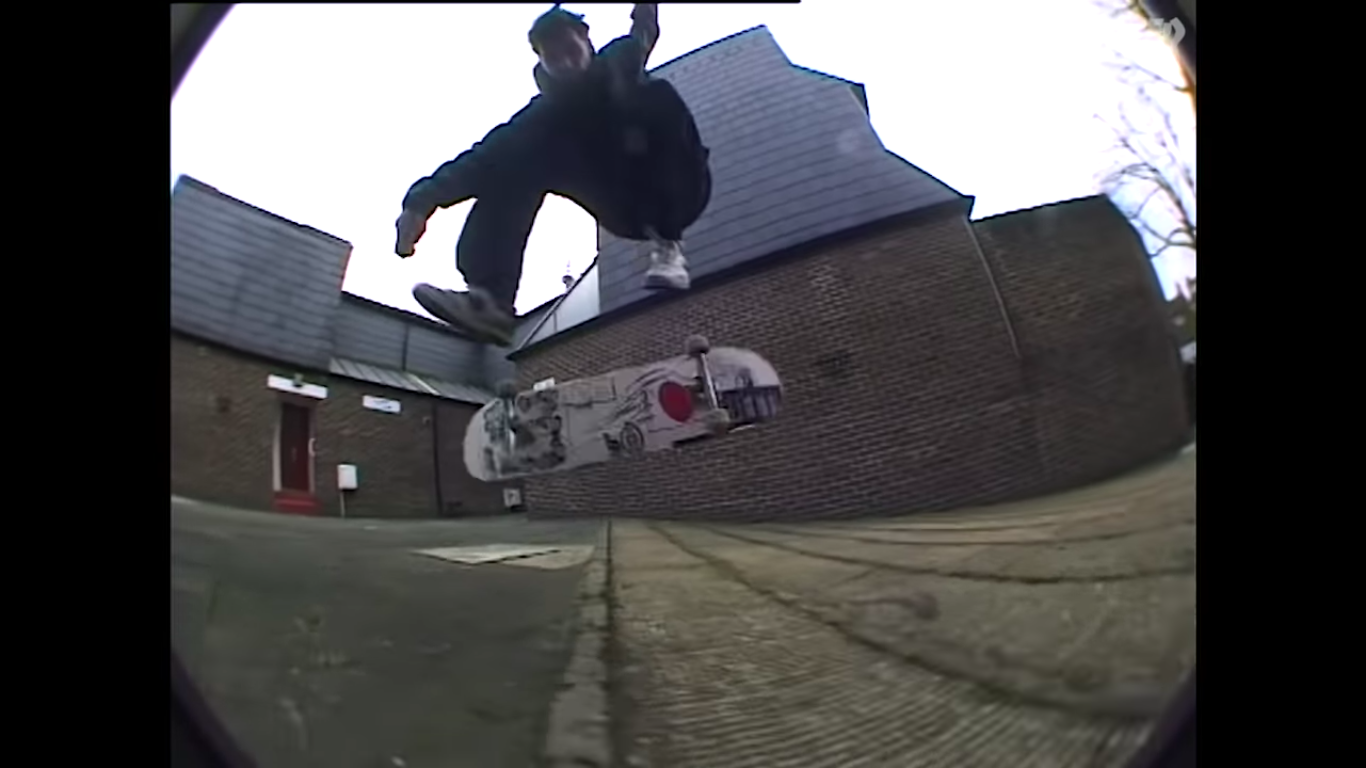London, a poem by Tom Knox
Most people imagine lines when they hear the name Tom Knox. And it’s true: his lines are masterful. But I would recommend to anyone—particularly those seeking a better understanding of why Atlantic Drift dedicated the entirety of episode 11 to his 10-minute long video part—that they first consider his approach to stairs. The sheer number of examples is proof enough: dozens of clips depict Knox taking the leap regular, switch, and fakie; out of a manual, just after a flip trick, or simply multiple times in a row. I resorted to stair-counting after witnessing his ender, but that’s all I’ll say about that. The point is, Knox on stairs requires us to zoom in and out on the map of London, offering sweeping vistas that frequently atomize into gritty detail. And vice versa. The perspective frequently shifts throughout the part, vacillating between the individual and the city, the spot and the trick, street-level and omniscience, the everyday and dreams. It represents Knox’s poetic ode to city life—or, at least, the virtues of skating this ancient capital.
To a foreign pair of eyes like mine, the way Knox skates stairs summons a charming, and irresistible London accent, but his disorienting shifts in scale take place in other vertically-oriented spots, as well. For his opening clip, he backlips a streetside parapet alongside an iconic red telephone box—clearly, the postcard fixture is meant to do more than give a sense of scale, rather, announcing London, broadly speaking, as the locus of operations. Other times, the stakes are localized to the roofs of bus shelters and neighborhood tube stations. He brings intimacy to a canopy that covers a dumpster by scaling up a slappy 5050 (a curb trick) to its ribbed metal roof. Earlier in the part, he similarly acid drops onto a utility box, and back 180s out, as if he were skating a knee-high ledge.
To a foreign pair of eyes like mine, the way Knox skates stairs summons a charming, and irresistible London accent, but his disorienting shifts in scale take place in other vertically-oriented spots, as well. For his opening clip, he backlips a streetside parapet alongside an iconic red telephone box—clearly, the postcard fixture is meant to do more than give a sense of scale, rather, announcing London, broadly speaking, as the locus of operations. Other times, the stakes are localized to the roofs of bus shelters and neighborhood tube stations. He brings intimacy to a canopy that covers a dumpster by scaling up a slappy 5050 (a curb trick) to its ribbed metal roof. Earlier in the part, he similarly acid drops onto a utility box, and back 180s out, as if he were skating a knee-high ledge.
Perhaps the most notable plot on the y-axis of his spot graph is represented by a back 180 switch 5050 down a cascading, waterfall-shaped tube station, which he mysteriously, beautifully pops out of. Here, as elsewhere, there is no misplaced gesture. The smallest movements are as important as the biggest banger, the difference with Knox being his knack for cadence and rhythm. This tendency frequently comes to bare on street gaps: a kickflip up a curb is arrested in space by an ollie over a sizable crosswalk; a switch heel to switch 5050 on a curb makes for a delightful anticlimax. But it’s not all quick-footed syncopation. Over another stretch of pavement, he kickflips into a nose manual, holding the latter trick across a rather long stretch of sidewalk. Knox ordinarily jams as much as possible into similar spaces, but here, he braces us against the ending, drawing out our attention for another beat or two. Though a less-than-heroic spot, you can’t not root for him by the time he reaches the other end, and nollies the second street gap.
To some extent, the way Knox approaches space marks him as a formalist, particularly when he relies heavily on repetition. A back 180 on a bizarre concrete volcano evolves into a backside big flip. After a smith grind on an Escher-like set of stairs introduces a line, he goes back and adds a kickflip. In some clips, repetition evolves into assonance: a 360 flip at the top of a bizarrely pitched bank is directly followed by a fakie 360 flip back into it. His hermeneutic, skating-for-skating’s-sake is most beautifully explored in a line that begins with a triple 5050, which he spreads across a line of modular fencing units. Tumbling one bar to the next as if delivering an incantation, he suddenly transitions to the street, slant rhyming the triple 5050 with a back 360 off the curb. He riffs for another 3 tricks, only to find his breaking point with a bailed fakie flip some distance, both physically and conceptually, from where he started.
To some extent, the way Knox approaches space marks him as a formalist, particularly when he relies heavily on repetition. A back 180 on a bizarre concrete volcano evolves into a backside big flip. After a smith grind on an Escher-like set of stairs introduces a line, he goes back and adds a kickflip. In some clips, repetition evolves into assonance: a 360 flip at the top of a bizarrely pitched bank is directly followed by a fakie 360 flip back into it. His hermeneutic, skating-for-skating’s-sake is most beautifully explored in a line that begins with a triple 5050, which he spreads across a line of modular fencing units. Tumbling one bar to the next as if delivering an incantation, he suddenly transitions to the street, slant rhyming the triple 5050 with a back 360 off the curb. He riffs for another 3 tricks, only to find his breaking point with a bailed fakie flip some distance, both physically and conceptually, from where he started.
Knox’s constant travails with bricks are perhaps the only time we question the reliability of his narration. A nollie flip into a brick pyramid tugs at his back truck so hard that he seems all but sure to fall. Somehow, though, Knox wobbles through it—a shaking of the knees conveying that he felt it too. Emblematic of the role skating often plays in city life, the lightness of his approach allows him to tackle the crustier, or less welcoming aspects of London’s infrastructure, which also dovetails with Knox’s mea culpa in the form of a pair of curb lines at the end of the video. The first comprises a nosegrind, an alleyoop 180 5050, and a switch front shuv 5-0 revert. The second: a front blunt, a front 5-0, and a big flip 5050. Honing his talents to the curb-level, it’s possible that these clips instruct us not to mistake bangers as distinct from flatground. That skating London is its own trick—perhaps even the trick he’s trying to get us to understand.
In the end, the fact that we are in Tom Knox’s London is underscored by the dreamlike quality his labyrinthine lines add to the part. And many are pleasingly on evidence, meandering through myriad contexts as if guided by some subconscious dream logic. A favorite involves a series of downhill, washboard-like steps into which he fakie flips, fakie ollies, and fakie heels, respectively, before cranking a switch front shuv over a low brick barrier. And I’d be remiss if I didn’t mention the ollie he boosts over a trash can to back lip on a curb, which he uncannily links to a bump to bar across the street, and finally concludes with a flatground frontside heel flip. Like adding a fried egg to a cheeseburger, he indulges every option. It might be too much of a good thing, but to me, it’s satisfyingly perverse.
In the end, the fact that we are in Tom Knox’s London is underscored by the dreamlike quality his labyrinthine lines add to the part. And many are pleasingly on evidence, meandering through myriad contexts as if guided by some subconscious dream logic. A favorite involves a series of downhill, washboard-like steps into which he fakie flips, fakie ollies, and fakie heels, respectively, before cranking a switch front shuv over a low brick barrier. And I’d be remiss if I didn’t mention the ollie he boosts over a trash can to back lip on a curb, which he uncannily links to a bump to bar across the street, and finally concludes with a flatground frontside heel flip. Like adding a fried egg to a cheeseburger, he indulges every option. It might be too much of a good thing, but to me, it’s satisfyingly perverse.
But the part’s most stunning segment is dedicated to a single spot, wherein Knox finds the material counterpart to his lines in an ouroboros-shaped public park. The first sequence in particular induces a dizzying relation to space. Physically, he loops around twice, bookending the line with a 360 flip and switch 360 flip down adjacent 4-stairs. The remaining tricks he crams into the space also help to convey us through this involuted dream world, and though they are too numerous to elaborate here, suffice it to say that even the 5050 pop up to 5-0 that he does on the long, curving granite bench mid-line contributes to an inversion of sense. It’s no surprise that an image of the late Ben Raemers pops up here. In this underworld of a spot, left is right, up is down, and regular is fakie.
No matter how enigmatic the line gets, Knox never strands us in his recursive loop. Yet, he never shows us the full picture either. Each disorienting shift of perspective is always countered by its opposite: a line that twists and turns throughout a single block is inevitably complemented by the sheer quantity of tricks he fits in; a clip on a set of stairs undoubtedly forces us to consider this otherwise generic spot in situ. As such, Knox conveys us throughout his version of London, where spots beget tricks, tricks beget spots, and lines emerge from the centuries of infrastructure that have piled up over time. Occasionally, it can seem as if Knox’s lines hold the key to London: they are so complex, that they appear to represent the full scope of its maze-like streets and spaces. But in so doing, they also represent a natural horizon: true to Knox’s dreamlike vision of the city, the beauty of his skating derives from that fact that we will never know the metropolis in full. •••
No matter how enigmatic the line gets, Knox never strands us in his recursive loop. Yet, he never shows us the full picture either. Each disorienting shift of perspective is always countered by its opposite: a line that twists and turns throughout a single block is inevitably complemented by the sheer quantity of tricks he fits in; a clip on a set of stairs undoubtedly forces us to consider this otherwise generic spot in situ. As such, Knox conveys us throughout his version of London, where spots beget tricks, tricks beget spots, and lines emerge from the centuries of infrastructure that have piled up over time. Occasionally, it can seem as if Knox’s lines hold the key to London: they are so complex, that they appear to represent the full scope of its maze-like streets and spaces. But in so doing, they also represent a natural horizon: true to Knox’s dreamlike vision of the city, the beauty of his skating derives from that fact that we will never know the metropolis in full. •••



